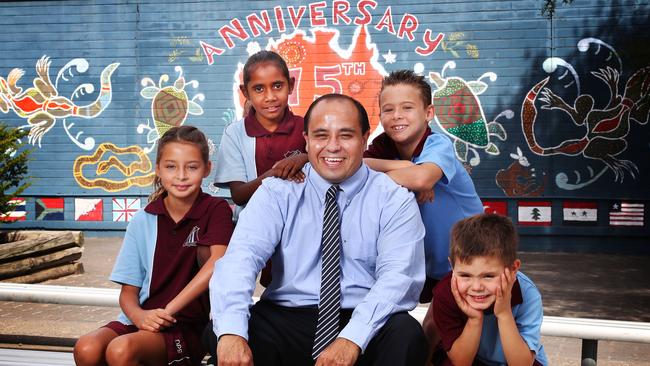“Needs” based school funding doesn’t work
ONE look at the NAPLAN results proves that so-called “needs” based school funding is a well-intentioned failure, writes Anjali Nadaradjane.
Rendezview
Don't miss out on the headlines from Rendezview. Followed categories will be added to My News.
THIS year, the Turnbull government decided to increase needs-based funding for school students by $24.5 billion over a period of ten years starting in 2018.
The Commonwealth hopes the extra dollars will lift education outcomes. However, experience makes it doubtful that the funding boost will actually improve educational outcomes for our students.
Over the past decade or so, the government has expended over $10 billion in ‘needs-based funding’ ostensibly to improve performance. In the 2013-14 period, the federal, State and territory governments spent an exorbitant $50.4 billion on schools — over 20 per cent more than the $40.7 billion spent between in 2004-05.
Despite these expensive efforts, education standards have been slipping. A slew of NAPLAN scores and international assessments consistently indicate that Australia’s students are significantly under-performing compared to their counterparts in other countries such as Japan, Singapore, Taiwan, Shanghai, Hong Kong, South Korea and Canada. Disturbingly, the Program for International Student Assessment (PISA) showed that Australian students’ mathematical, literacy and reading performance had declined by nearly half — from 29 points to 16 points between 2000 and 2012. In mathematics, PISA results fell from 20 per cent in 2003 to 15 per cent in 2012 and in reading, the top performers fell from 18 per cent to 13 per cent within the same period.

Poor results in the face of staggering expenditure should be a wake-up call to the government to shift their approach away from the defective needs-based funding approach. Just throwing money at schools does not lead to better academic performance and must be reconsidered at a time when our gross public debt is ballooning past $600 billion dollars — a shocking $40,000 for every Australian household.
The notion that under-performance in the education system is closely linked to economic disadvantage has gained prominence in the post-Gonski era. Some disadvantages seen as material to academic performance include low parental income, parental unemployment, disability, remote location, school size, indigenous status or lack of English proficiency. Public funding is provided to each school based on these measured needs. Policy makers, with good intentions, hope that this will create a more consistent, transparent and equitable school funding system.
However, this needs-based funding model is flawed for many reasons. Studies find that a family’s socioeconomic standing accounts for only a marginal 15 per cent of student achievement. There are both cases of socially advantaged schools performing poorly in NAPLAN and of socially disadvantaged schools performing better than seemingly more privileged schools. The decline in NAPLAN results is a performance issue across the school system rather than a result of socially disadvantaged schools which represent a minority of cases.
Needs-based funding is also typified by a lack of certainty. There is no guarantee that the money provided will be spent on performance-enhancing activities. We know, for example, that the 2009 ‘Building the education revolution’ program of the then Rudd government resulted in expensive, unnecessary and often bungled projects by contractors who were often paid well over the market rate. Experts such as Andreas Schleicher of the Organisation for Economic Cooperation and Development, similarly find that, contrary to conventional thinking, hiring more teachers to create smaller class sizes does not lead to improved student performance and is contradicted by successful educational outcomes in several East Asian school systems.
Secondly, the funds are often wasted on outdated educational practices. The sliding academic results of Australian students are the consequence of this misdirected spending.
For decades, the education debate in Australia has been disproportionately focused on inputs. Rather than continuing to squander what’s in the public purse, Minister for Education Simon Birmingham should focus on output: performance improvement and how each school system can improve student learning. Outcome-based models fund institutions which focus on how well students perform and progress according to an assessment system that aims for transparency.

Higher education institutions already follow outcome-contingent funding which makes them more accountable for the outcomes of their students and therefore more transparent in their choices. This places greater emphasis on aligning their interests towards students and taxpayers — focusing on teaching and research quality, graduate outcomes and student satisfaction. Although these institutions tend to prioritise academic research over teaching outcomes to obtain higher rankings and repute in the world tables, the focus on output is certainly far preferable to the currently deffective school funding model.
Outcome-based funding will have many positive impacts on our primary and secondary schools. It would reserve a portion of school resources for performance improvement. It measures student progress and key school indicators, allowing for effective assessment of where gains are made and where resources are most effectively allocated. It also directs attention towards high quality teaching methods and evaluating successful teaching practices and school programs. This means that those methods deemed most effective, can then be adopted across a wider range of schools, ensuring the best value for money in delivering results.
Rather than conceding to the Labor party’s false and emotion-driven narrative that our schools aren’t funded enough, the government needs to change tack and prioritise a more effective strategy.
Dismal NAPLAN results in recent times highlight the unconscionability of wasting more taxpayer funds on ineffective “needs-based” funding strategies. Outcome-based funding has already been successfully implemented in countries such as Brazil to create an index for each primary school — following each school’s trajectory and measuring its progress.
We must take this approach if our children and grandchildren are to take on the rest of the world.
Anjali Nadaradjane is a Research Associate with the Australian Taxpayers’ Alliance.


